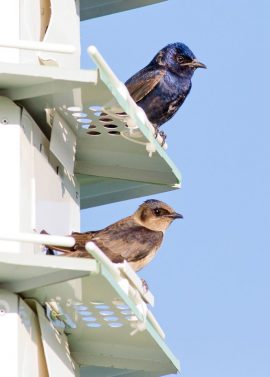By Ashley Peele

Purple Martin foraging (Bob Schamerhorn)
Migratory birds, particularly those colorful, diverse species that spend winter in the Neotropics and summer in the US, add a new dimension to collecting breeding data for the VA Breeding Bird Atlas. Breeding codes should be used carefully in the late Spring and early Summer. For some species, e.g. the Eastern Wood-Pewee or Purple Martin, individuals begin arriving in Virginia much earlier than they start to breed. Purple Martins begin arriving in VA as early as February, but the conditions in that early spring season are not conducive to breeding yet. So! The Purple Martins hang out with us for a while, before initiating their breeding efforts. The same is true of the Pewee who can be heard singing in the forests by early April. When that plaintive song starts echoing through the woods, it is tempting to immediately start using the S code (Singing Male) on our checklists. However, Pewees don’t typically begin breeding until late May and additionally, spring migration continues to roughly that same time.
These characteristics of migratory species mean that Atlas volunteers should refrain from adding Possible and several Probable breeding codes until two things have occurred: 1- passage migrants are no longer likely to be moving through VA and 2- a given species is within it’s breeding season window. Rule #1 is important, because many species exhibit low-level breeding behaviors while on migration. Consider all the testosterone coursing through those little male warblers. Hormone levels begin increasing while migrants are still on the winter grounds. It helps them to prepare for migration, leave

Purple Martin male and female (Bob Schamerhorn)
earlier, and push harder to arrive in their summer breeding territories first. It also means that some migrants are keyed up for aggressive interactions, early courtship behaviors, etc. Most migratory songbirds sing throughout migration, many fight with each other, others exhibit territorial behavior, which all means that some breeding codes like H, S, S7, T, P, and A could easily be applied to a passage migrant who is not going to breed at the location an observation was made.
Additionally, rule #2 applies to all potential breeding species, including residents. Just as we don’t code a Pewee as a Singing Male (S) when it first arrives in April, we also don’t code a Northern Cardinal as S in January. Volunteers should always consider what these codes imply. If it is doubtful that a species is actually breeding yet, low-level codes such as singing can wait until the observer is confident that the breeding season has begun.
Given all these nuances, how should a volunteer know when a species IS actually likely to be breeding? The Atlas project has produced a series of Breeding Season Guidelines charts for the three major eco-regions of Virginia, the Coastal Plain, Piedmont, and Mountain/Valley. These charts provide the approximate windows for migration, breeding season, and the transition time in between sourced from historic records for VA and surrounding states. Links to each are found here…
Coastal Plain — Piedmont — Mountain/Valley
These are housed on the Atlas website in the ‘Handbook and Materials’ page. Please use these charts to inform your use of breeding codes with migratory species. The nuances are part of the learning process, so don’t be discouraged but instead continue building your knowledge of VA’s birds, their behaviors, and seasons.
Thanks for all your efforts on behalf of the VABBA2!
~Dr. Ashley Peele – State Coordinator, Virginia Breeding Bird Atlas

